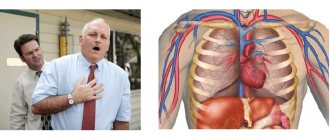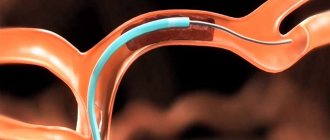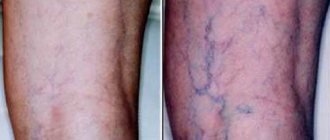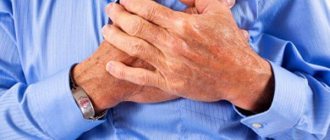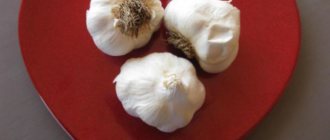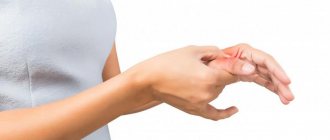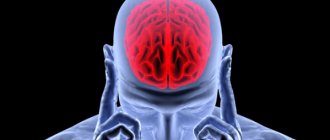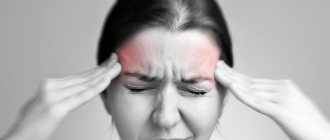If the veins in the legs hurt, then the reason for this is varicose veins (dilation, formation of nodes), venous insufficiency (swelling, night cramps), thrombosis (sharp pain, redness, cyanosis), thrombophlebitis, phlebitis (severe pain, hardening of the vein, red stripes along the course of the vessel).
Raising the lower extremities to an elevated position, a cold compress, ointment, or gel with heparin can help temporarily alleviate the condition. Folk remedies and diet, exercises will help increase the effectiveness of treatment with venotonics (Phlebodia, Detralex), external drugs (Troxevasin gel, Lyoton). To radically relieve pain in the legs, surgery, sclerotherapy, laser or radiofrequency ablation are prescribed.
The main reasons why leg veins hurt
The main reasons why the veins in the legs may hurt are their varicose veins, blood stagnation due to venous insufficiency, blockage by a blood clot (thrombosis), inflammation (phlebitis), and a combination of thrombosis and phlebitis (thrombophlebitis). Signs of venous pain are heaviness in the legs, swelling, night cramps, skin changes (darkening, eczema, trophic ulcer).
We recommend reading the article on how to get rid of pain from varicose veins. From it you will learn about the causes of pain, how to relieve pain, as well as the effectiveness of folk remedies. And here is more information about cramps with varicose veins.
Aching and twisting from physical exertion
The venous vessels in the leg can hurt from physical activity, and patients describe their sensations this way: the feet burn, the legs ache, twist, and the vein in the leg burns or pulls. It is important that pain and heaviness in the limbs are caused only by static types of loads - lifting weights, staying in a standing position, prolonged muscle tension in one position. Walking and swimming, on the contrary, prevent venous stagnation.
Often patients cannot distinguish between muscle and venous pain. The first is also accompanied by aching and pulling sensations. It appears due to the accumulation of lactic acid, which provokes pain and microtears of muscle fibers. Venous pain is characterized by:
- swelling,
- heaviness in the legs,
- darkening of the skin,
- cramps at night.
External manifestations include an expanded network of blood vessels, swelling and thickening of the vein, but they reflect already far-reaching changes or complications of vascular diseases.
Veins hurt in the arms and legs: causes
In order to understand what causes pain in the veins in the arms and legs (phlebitis, thrombophlebitis, varicose veins, venous insufficiency), it is necessary to take into account several distinctive signs.
| Disease | Risk factors | Why do veins hurt? | Symptoms |
| Phlebitis | Varicose veins (enlarged veins), infection, injections into a vein, childbirth (postpartum) | Inflammation of the wall | The vein is tense, red stripes, the skin is hot, swollen, body temperature is increased |
| Thrombophlebitis | Phlebitis, varicose veins, increased blood clotting, trauma, surgery | Blockage by a blood clot (thrombus) | Severe sudden pain and swelling of the leg, aggravated by walking, local and general increase in temperature, vein in the form of a dense painful tourniquet |
| Varicose veins | Congenital weakness of the vein walls, heredity, female gender, obesity, contraceptives, pregnancy, old age, static loads, diet lacking vegetables, constipation | Due to a weak wall, veins expand, blood stagnates, and valves collapse | Visible dilatation, congestion of convoluted, nodular veins, swelling, cramps in the lower leg, complications - ulcer, thrombophlebitis, rupture and bleeding |
| Venous insufficiency | Varicose veins, thrombophlebitis, congenital venous pathologies | Accumulation of blood in the veins, obstruction of outflow, valve weakness | Pain, heaviness, swelling, initially disappears after rest, then persistent, darkening of the skin of the legs, thickening, eczema, ulcer (visible varicose veins may or may not be present) |
| Thrombosis | Trauma, infection, bed rest, tumor, childbirth, sedentary work, low mobility | Vein damage, slow blood flow, increased clotting, thick blood | Distension, swelling, pain when walking and pressing, swelling of veins, redness or bluishness of the skin |
Expert opinion
Alena Ariko
Expert in Cardiology
It is important to note that the vast majority of venous pain is localized in the lower extremities. Pain throughout the body is characteristic of damage to the nervous system (neuritis, neuralgia, neuropathy, fibromyalgia).
Manifestations
Symptoms vary depending on how the veins in your legs hurt. It depends on the initial reasons that caused the pathology.
Varicose veins are characterized by:
- pain localized in the lower leg area and having an aching, bursting character;
- fast fatiguability;
- increased muscle tone;
- feeling of numbness;
- swelling, burning and tingling in the feet;
- stretching in the knee area.
With thrombophlebitis, a person feels:
- acute pain syndrome in the lateral part of the knee (the sensation intensifies when a person stands; the legs swell, it becomes difficult to walk);
- burning in a venous vessel;
- the appearance of a tangible strand.
Thrombosis is accompanied by:
- severe pain inside, which is felt during palpation;
- swelling of the area around the knee joint;
- local increase in temperature;
- pain in the knee (appears when moving the feet).
Postphlebitic syndrome is associated with:
- feeling of weight in the legs;
- pain (aching, bursting nature);
- gait disturbance (limping), the occurrence of pain radiating to the thigh and calf;
- development of varicose veins, hyperpigmentation (changes in color of the epithelium in the painful area);
- the formation of weeping eczema, varicose veins, ulcers.
These signs must be correctly differentiated, since the correctness of prescribing subsequent instrumental diagnostic studies depends on this.
How veins hurt in the legs, symptoms of pathology
If the veins in the legs hurt, then other symptoms of vascular pathology also appear at the same time: swelling, cramps, skin signs.
Painful sensations
Pain does not always appear with severe varicose veins. Even with single lesions of the veins, there can be severe discomfort. In case of significant circulatory impairment, on the contrary, there is no pain due to decreased sensitivity. The mechanism of pain in venous diseases:
- the walls are stretched due to weak tone;
- blood accumulates in the veins, causing them to swell and overflow;
- stagnation of fluid, swelling compresses blood vessels and nerves, stretches the tendon membranes of the muscles.
All these conditions are accompanied by irritation of pain receptors. At the same time, some patients feel tingling and slight pain in the lower leg, behind the knee or on the thigh, and in severe cases, burning, aching, and then bursting pain appears. At the initial stage it subsides after rest, and then its intensity no longer decreases, but only increases.
Sharp pain in a vein in the leg is dangerous, as this is one of the signs of blockage of the vessel - thrombosis or thrombophlebitis.
Edema
Swelling on the top of the foot, around the ankle joint, appears with varicose veins and its consequences - phlebitis, thrombophlebitis, postthrombophlebitis syndrome, venous insufficiency. It is caused by the fact that when the venous network overflows, the pressure increases. This promotes the transition of the liquid part of the blood into soft tissues.
At the initial stage, swelling appears in the evening, and after a night's sleep or resting with elevated legs, it subsides. As the disease progresses, swelling persists in the morning, and the skin becomes thinner.
Cramps at night
Normally, muscle fibers relax at night. Changes in tissue explain why spastic muscle contractions occur:
- accumulation of metabolic products that are not eliminated due to blood stagnation;
- swelling reduces blood flow through the arteries (vessels contract), which reduces the supply of oxygen and glucose;
- energy production slows down;
- the ratio of calcium and magnesium changes.
Lack of nutrition (ischemia) and metabolic disorders lead to seizures. They appear much less frequently during the day, as muscle work increases blood flow. There is no physical activity at night, so heaviness, swelling and twitching are more disturbing. This reduces the quality of sleep, leading to insomnia and chronic fatigue.
Skin signs
At the early stage of venous insufficiency, the skin is not changed or there are individual spider veins, small visible dilations of the veins. Gradually they become overcrowded and clearly appear through the skin. During the day, skin itching is the first to occur in the evenings. It is considered a harbinger of nutritional disorders - trophic disorders. Severe venous circulation disorders manifest themselves:
- dense, tense and painful veins;
- the vessels are tightly fused to the skin;
- after inflammation, depressions appear;
- the color of the skin is dark, there are lesions with a bluish or red tint;
- the skin gradually becomes thicker, dry, and does not fold.
Spider veins on the legs
The first zones of trophic complications are localized on the lower leg - along the front, inner surface, closer to the ankle joint. After the itching, eczema (chronic inflammation) appears, and then ulcerative defects.
Surgical correction: phlebectomy
If veins pop out on your legs, what should you do? Treatment can also be carried out surgically. Moreover, this method is the oldest and most frequently used. It is worth noting that this is the only method that guarantees that varicose veins will not appear on the treated area again.
The operation is performed under general or epidural anesthesia. There are several methods that doctors use to remove a problematic vein. After correction, you must use compression garments and take the necessary medications.
Inflamed veins in the legs: what to do
If the veins in your leg are inflamed, then the first thing to do is contact a phlebologist or surgeon (preferably a vascular surgeon). Before the visit, you can apply cold yourself and lubricate with heparin ointment. For prevention, folk remedies, diet and exercise are used.
What to do on your own to alleviate the condition
If the veins in your legs are swollen and painful, then you can help relieve the condition yourself:
- elevated position - place a folded blanket or pillow under your feet, it is good to lift them up for a while (lying on your back) to improve blood flow;
- cold compress with Kalanchoe juice, aloe - a tablespoon per 50 ml of water, moisten a cotton cloth with this solution and apply to the affected area for an hour;
- lubrication with ointment or gel with heparin.
Pillow under the legs for varicose veins
These measures are temporary; if a vein comes out, becomes hard and hurts, then this can be dangerous, since inflammation is often complicated by the formation of a blood clot. A blood clot blocks a vessel, blocking the flow of blood. The development of thrombophlebitis threatens:
- spread of infection through the venous network;
- detachment of a blood clot and its movement into the pulmonary arteries;
- thromboembolism of pulmonary vessels with a risk of death (signs: sudden difficulty breathing, sharp chest pain, cough streaked with blood).
Therefore, self-medication and the use of traditional methods and exercises are strictly prohibited until the possibility of complications is eliminated.
Traditional medicine recipes
If the examination does not reveal the danger of deep vein thrombosis, then traditional methods may be included in the treatment complex:
| Method | Ingredients |
| Chestnut tincture | For 10 finely crushed fruits, take 500 ml of vodka, leave for 20 days in a dark container, filter, take 30 drops 3 times a day, dissolved in 50 ml of water, smear the protruding veins with the tincture before bedtime. |
| Collection for blood thinning | 40 g of willow bark, peony flowers and raspberry leaves, 20 g of sweet clover and flax grass, pour a tablespoon of boiling water, keep on the lowest heat for 10 minutes and filter, take 50 ml 3 times a day for 2 months. |
| Composition for strengthening venous walls | Mix meadow lumbago, rue and verbena in equal parts, you will need a tablespoon of plants (with the top) per 300 ml of water, leave overnight in a thermos, drink 100 ml 3 times a day for 1 month. |
If the veins are already dilated, there are signs of inflammation (pain, swelling, hot skin), then it is too late to treat with herbs. They are effective only at the first signs of varicose veins - slight pain and swelling in the evening, completely disappearing by the morning.
Diet and nutrition
Nutrition can help treat varicose veins; for this purpose, the diet includes:
- fresh and boiled vegetables, juices;
- whole grain porridge;
- boiled or baked lean meat or fish;
- berries, fruits, dried fruits;
- black bread, with bran;
- fermented milk drinks without additives;
- cottage cheese 2-5% fat;
- vegetable oil, nuts;
- clean drinking water (1.2-1.5 liters), compotes from berries, dried fruits, fruit drinks (0.3-0.5 liters).
Prohibited are foods that retain fluid in the body, as well as those that increase blood thickness:
- fatty meat, semi-finished products, offal;
- fats, broths (meat, mushroom, fish);
- fried, spicy, salty foods;
- marinades, smoked foods, canned food;
- sweets, flour;
- alcoholic drinks.
Exercises
Even with acute inflammation, strict bed rest is not recommended, but independent exercise is allowed only in the absence of severe pain, swelling and fever . Therapeutic gymnastics includes:
- walking on toes, heels, outer and inner surfaces of the foot;
- sitting on the floor with straightened legs, first bend the fingers, then the feet, perform circular rotations in the ankle joint;
- movements with bent legs in the air - imitation of riding a bicycle;
- raising your legs 90 degrees and fine vibration (shake your legs).
If your legs are heavy and tired in the evenings, it is recommended to spend at least 20-25 minutes doing gymnastics, raising your legs as often as possible while resting.
Watch the video about exercises for varicose veins:
Quickly relieve pain using folk remedies
You can quickly eliminate pain from varicose veins using traditional medicine methods. But it should be understood that this is a temporary solution that will not help cure the disease itself, but will only alleviate the patient’s condition.
The following procedures have worked well:
- Foot baths are the ideal solution for foot pain. A decoction of sage or mint should be added to warm water to enhance the effect. Apple cider vinegar will relax blood vessels well, at a concentration of 10 ml per 1 liter of total liquid.
- Compresses – cabbage leaves perfectly relieve inflammation and pain. They do not need to be pre-cooked, just wrap the leg in a fresh leaf and cover it well with gauze, a bandage or a cotton towel.
- Tinctures for rubbing - prepared from horse chestnut fruits. This product contains saponins and flavonoids, which have a tonic effect. They have a positive effect on the functionality of the veins.
Treatment if the veins in the legs hurt due to pathologies
If the veins hurt, then treatment includes taking medications orally (Detralex, Aescusan), inflamed and tense areas are smeared with gel with heparin, troxevasin. For severe pain, painkillers are used in tablets (Indomethacin), suppositories (Diclofenac), and injections (Ketonal). Surgery, sclerotherapy, and laser cauterization help to radically improve the condition.
Which doctor should I contact?
Medicine for pain in the veins in the legs is prescribed by a phlebologist or vascular surgeon. If there are no such specialists nearby, you can contact a general surgeon. It is impossible to cope with varicose veins and venous insufficiency on your own, since it requires action on the entire vascular system, blood clotting, elimination of inflammation and the threat of blockage of veins. The therapy is long-term – at least 3 months.
Diagnosis of the condition
Before recommendations for treatment, a doctor’s examination and functional tests are carried out:
- Valsalvas - in a supine position, the patient straightens his legs (the veins collapse); after coughing or tensing the abdominal muscles, the vessels with varicose veins fill with blood and appear;
- three tourniquets - on the knee (above and below), rubber tourniquets are applied to the thigh, the patient walks for 30 seconds, then they are removed and the area where blood flow is disrupted is identified;
- Rendelenburg-Troyanov-Brody T - the subject raises the leg 90 degrees, the doctor uses massaging movements to achieve the outflow of blood, then applies a tourniquet to the upper third of the thigh and the patient stands up, after removing the tourniquet in case of venous insufficiency, the blood moves from top to bottom and the veins of the lower leg quickly fill, and Normally this happens in 30 seconds or more.
All these methods are needed only to identify hidden venous pathology and determine the need for further examination:
- Vascular ultrasound with Doppler ultrasound – allows you to assess the speed and direction of blood movement, the presence of blood clots;
- venography - filling of veins with contrast with radiographic control or using MRI, the study shows the patency of the veins and communications between the superficial and deep network;
- radionuclide scanning – study of the distribution of a radioactive isotope;
- blood tests for coagulation - platelets (general analysis), D-dimer, proteins C and S, antithrombin, antibodies (antinuclear, antiphospholipid).
Phlebography for varicose veins
What medicine will the doctor prescribe?
When treating leg pain caused by venous pathology, drugs with the following actions are used:
- increasing venous tone - Aescusan, Detralex, Phlebodia, Troxevasin, Angionorm, Cyclo-3-fort, Vasobral, Ginkor fort;
- blood thinners (in the presence of a blood clot or a tendency to form blood clots) - Fragmin, Warfarin, Aspirin;
- improving blood circulation - Trental, Curantil;
- resolving already formed clots - Streptokinase, Urokinase.
Watch the video about drugs for varicose veins:
How to smear inflamed veins
You can smear inflamed veins with external agents that reduce swelling and facilitate blood movement:
- Lyoton,
- Heparin gel,
- Troxevasin gel,
- Indovazin gel,
- Phleboton gel,
- Venitan forte gel,
- Thrombocide gel,
- Antistax gel.
Suppositories, tablets and painkillers
In case of severe pain, painkillers are prescribed for a short period of time - 3-5 days. They are always used with medications that improve blood flow and increase the tone of the venous walls. As swelling disappears and blood circulation in the extremities is restored, the need for pain relief disappears.
Ibuprofen, Nimesulide tablets, Ketonal injections, suppositories with Indomethacin, Diclofenac may be recommended. The latter form of release is considered the most effective and safe if the patient has stomach diseases.
Compression from pain in veins
Wearing compression stockings helps prevent swelling and therefore pain in the legs.
Socks and stockings with different degrees of compression (compression class) are used. For preventive purposes, the first one is suitable, and in case of severe circulatory disorders, the type of knitwear is selected by a doctor. An alternative method, but less effective, is to fix the lower leg and thigh with an elastic bandage.
Surgical and minimally invasive methods
In the treatment of severe venous insufficiency, drugs help little, they only stop the progression of the disease, but they often fail to completely remove swelling and pain. Such patients are shown:
| Procedure | How to do it |
| Sclerotherapy | Disabling the affected vessel by injecting a hardening solution |
| Laser therapy | Cauterization of the vein, leading to its closure, is used for small dilated vessels |
| Laser, radio wave ablation | A catheter is inserted into the vessel, which acts on the walls of the vein from the inside, the flow of energy destroys the walls and leads to their gluing |
| Phlebectomy, miniphlebectomy | The affected vessel is removed |
| Reconstruction of blood flow | Restoring blood flow by creating a bypass (venous bypass) |
Without exception, all methods of surgical correction can eliminate the problem only in a local area of the venous network. They do not exclude repeated relapse on adjacent venous branches. Therefore, after operations or instrumental treatments, wearing compression stockings and using medications for internal and external treatment are prescribed.
It is important to eliminate risk factors (constipation, excess weight), normalize nutrition and physical activity.
Preventive measures
Before taking analgesics, applying creams, or resorting to surgery, you can try to relieve pain through lifestyle changes.
- Be sure to review your diet. Eating healthy foods will not have an analgesic effect, but will prevent the development of changes in the venous walls.
- The use of vitamins and microelements to maintain the elasticity of venous vessels.
- Self-massage using essential relaxing oils.
- Special exercises to eliminate swelling.
- Lifestyle changes, in particular quitting smoking, drinking alcohol and carbonated drinks.
Preventive measures allow you to “slow down” the development of vascular pathology, and accordingly prevent the occurrence of discomfort.
Prognosis for the patient
The most favorable prognosis for venous diseases occurs when you consult a doctor at the earliest stage - when heaviness and slight swelling of the legs appear. Then it is possible, with the help of medications, proper nutrition, and gymnastics, to strengthen the blood vessels and facilitate the outflow of blood.
After the pain and swelling have become constant and do not subside after rest, it is only possible to slow down the progression of the disease by wearing compression stockings or mini-surgery. Therapy is carried out for a very long period of time, but its success is not always high.
In severe cases of venous insufficiency, previous thrombosis, thrombophlebitis in the lower extremities, blood circulation is persistently impaired. Surgical treatment and lifelong use of drugs, monitoring the condition of the vascular bed are mandatory.
Blockage of the deep veins of the leg is especially dangerous. There is a risk of a blood clot breaking off and moving to the lungs, with fatal consequences. In such cases, to prevent this complication, a trap - a vena cava filter - can be installed in the vena cava.
Complications and prognosis
Pain in the vessels often signals varicose veins. An undetected, advanced disease in time is fraught with the occurrence of thrombosis and thrombophlebitis, and can provoke serious circulatory disorders, organ ischemia, myocardial infarction, and lead to the death of the patient. The situation is especially concerning when black veins begin to appear through the skin.
With timely diagnosis and adequate treatment, the disease is successfully eliminated without leaving any consequences.
Measures to prevent vein problems
In order to prevent the expansion of veins and deterioration of blood outflow, it is necessary:
- avoid overheating in the sun, sauna, hot bath;
- eat right, focusing on plant foods, minimally processed foods, limit salt, spices, alcohol;
- do not carry heavy loads, reduce strength loads, choose swimming, yoga, therapeutic exercises, Pilates, walking, running, cycling among sports activities;
- When working sedentary or standing, do a warm-up every hour (stand on your heels, toes, rotate your feet, walk);
- do not wear clothes that tighten the waist, thighs, tight shoes or high heels;
- rest with your legs elevated;
- every day, alternately pour hot and cold water over your feet (contrast shower);
- reduce weight if you are overweight;
- when taking hormonal drugs, contraceptives, once every 3-4 months, undergo a preventive course of treatment with venotonics (Eskuzan, Troxevasin), hirudotherapy (placement of leeches).
We recommend reading the article about the first signs of a blood clot. From it you will learn about the causes and stages of blood clot formation, symptoms and consequences. And here is more information about the treatment of veins and blood vessels in the legs.
Pain in a vein is associated with varicose veins, venous insufficiency, inflammation during thrombophlebitis, and blockage of a vessel with a blood clot during thrombosis. It is accompanied by swelling, night cramps, darkening of the skin. In severe cases, trophic ulcers form. To treat the initial manifestations, medications, folk remedies, and diet are prescribed; at a later stage, surgery, sclerotherapy, cauterization with radio waves, or laser are needed.


